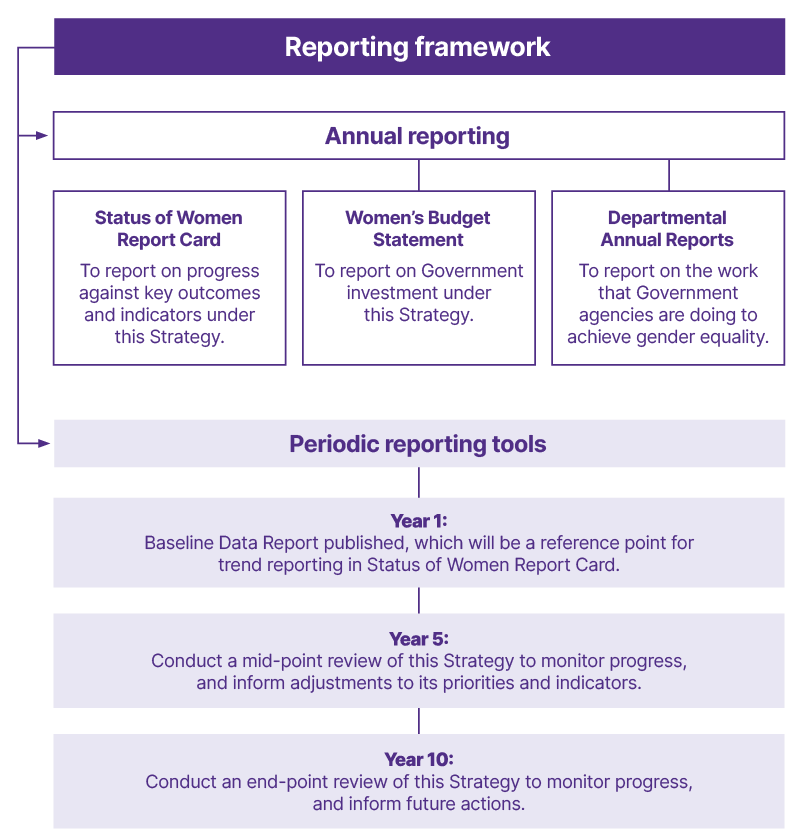
Reporting framework text description
Annual reporting:
- Status of Women Report Card: To report on progress against key outcomes and indicators under this Strategy
- Women's Budget Statement: To report on Government investment under this Strategy.
- Departmental Annual Reports: To report on the work that Government agencies are doing to achieve gender equality.
Periodic reporting tools:
- Year 1: Baseline Data Report published, which will be a reference point for trend reporting in Status of Women Report Card.
- Year 5: Conduct a mid-point review of this Strategy to monitor progress, and inform adjustments to its priorities and indicators.
- Year 10: Conduct an end-point review of this Strategy to monitor progress, and inform future actions.
Detailed reporting framework with outcomes and indicators
Vision
An Australia where people are safe, treated with respect, have choices, and have access to resources and equal outcomes no matter their gender.
Foundation and priority areas
a aligns with targets under the outcomes framework of the National Plan to End Violence against Women and Children 2022–2032
b aligns with commitments and priority areas under the National Women's Health Strategy 2020–2032 and National Men's Health Strategy 2020–2030
c aligns with targets and outcomes under Closing the Gap
d aligns with the Australian Government's targets for gender balance on Australian Government boards
Foundation: Gender attitudes and stereotypes
| Outcomes | Indicators | Actions that drive change |
|---|---|---|
| Community attitudes and beliefs in Australia reject gender inequality |
|
|
| People are not limited by gender roles |
|
|
Priority area 1: Gender-based violence
Ambition: End violence against women
| Outcomes | Indicators | Actions that drive change |
|---|---|---|
1.1 All people live free from violence and are safe at home, at school, at work, in the community and online Note: Indicators relating to the outcome 'employers support an end to gender discrimination, and sexual harassment and violence in the workplace' are detailed under Outcome 3.3 |
|
|
Priority area 2: Unpaid and paid care
Ambition: Balance unpaid work; Close the gender pay gap
| Outcomes | Indicators | Actions that drive change |
|---|---|---|
2.1 The unpaid work and care gap between women and men narrows |
|
|
2.2 Parents and carers have access to affordable and high-quality early childhood education and care services |
| |
2.3 The gap between women and men working part-time or flexibly narrows |
| |
2.4 The gender gap in use of and access to paid parental leave narrows |
| |
2.5 Men's representation in the care and support workforce increases |
|
Priority area 3: Economic equality and security
Ambitions:
- Close the gender pay gap
- Close the retirement income gender gap
| Outcomes | Indicators | Actions that drive change |
|---|---|---|
3.1 The gender pay gap closes |
| |
3.2 Industries and occupations are less gender segregated |
|
|
3.3 Employers support an end to gender discrimination, and sexual harassment and violence in the workplace Note: outcomes relating to gender-based violence at work are detailed under Indicator 1.1 |
| |
3.4 The retirement income gap closes |
| |
3.5 Women have access to homelessness services and secure long-term housing |
| |
3.6 The proportion of women-owned businesses increases |
|
Priority area 4: Health
Ambition: Gender equity in healthcare access and outcomes
| Outcomes | Indicators | Actions that drive change |
|---|---|---|
4.1 The health care system recognises and is responsive to gendered health issues and provides women and men with increased access to information, diagnosis, treatment and services |
|
|
4.2 Women have choice and access to safe and affordable maternal, sexual and reproductive health care |
|
|
4.3 The mental health of women, men and gender diverse people improves |
|
Priority area 5: Leadership, representation and decision-making
Ambition: Close leadership and representation gender gaps
| Outcomes | Indicators | Actions that drive change |
|---|---|---|
5.1 There are more women across all levels of political, judicial and public service leadership and decision-making |
|
|
5.2 There are more women across all levels of non-government leadership and decision-making |
| In addition to the above actions under outcome 5.1:
|
5.3 Women's participation in sport increases across all levels, including in positions of leadership |
| |
5.4 Women are recognised equally through the Australian honours system |
| |
5.5 More women influence and are represented in media |
|